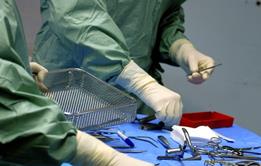Standardised mortality ratio of admissions from selected causes considered amenable to healthcare that resulted in death
Metric
Standardised mortality ratio of admissions from selected causes (various ages under 75) considered amenable to healthcare that resulted in death.
Observed
Spells with a method of discharge of death (DISMETH = 4) among cases meeting the inclusion and exclusion rules for the denominator.
Spells meeting the following criteria:
- Intestinal infections (ICD-10 A00-A09, ICD-9 001-009, ages 0-14 years;
- Tuberculosis (ICD-10 A15-A19, B90; ICD-9 010-018, 137), ages 0-74 years;
- Other infectious diseases (diptheria, tetanus, poliomyelitis) (ICD-10 A36, A35, A80; ICD-9 032, 037, 045), ages 0-74 years;
- Whooping cough (ICD-10 A37, ICD-9 033), ages 0-14 years;
- Septicaemia (ICD-10 A40-A41, ICD-9 038), ages 0-74 years;
- Measles (ICD-10 B05, ICD-9 055), ages 1-14 years;
- Malignant neoplasm of colon and rectum (ICD-10 C18-C21, ICD-9 153-154), ages 0-74 years;
- Malignant neoplasm of skin (ICD-10 C44, ICD-9 173), ages 0-74 years;
- Malignant neoplasm of female breast (ICD-10 C50, ICD-9 174), ages 0-74 years;
- Malignant neoplasm of cervix uteri (ICD-10 C53, ICD-9 180), ages 0-74 years;
- Malignant neoplasm of unspecified part of the uterus and body of the uterus (ICD-10 C54-C55, ICD-9 179, 182), ages 0-44 years;
- Malignant neoplasm of testis (ICD-10 C62, ICD-9 186), 0-74 years;
- Hodgkin’s disease (ICD-10 C81, ICD-9 201), ages 0-74 years;
- Leukaemia (ICD-10 C91-C95, ICD-9 204-208), ages 0-44 years;
- Diseases of the thyroid (ICD-10 E00-E07, ICD-9 240-246), ages 0-74 years;
- Diabetes mellitus (ICD-10 E10-E14, ICD-9 250), ages 0-49 years;
- Epilepsy (ICD-10 G40-G41, ICD-9 345), 0-74 years;
- Chronic rheumatic heart disease (ICD-10 I05-I09, ICD-9 393-398), ages 0-74 years;
- Hypertensive disease (ICD-10 I10-I13, I15 ; ICD-9 401-405), ages 0-74 years;
- Ischaemic heart disease (ICD-10 I20-I25, ICD-9 410-414), ages 0-74 years;
- Cerebrovascular disease (ICD-10 I60-I69, ICD-9 430-438), ages 0-74 years;
- All respiratory diseases (excl. pneumonia, influenza and asthma) (ICD-10 J00-J09, J20-J44, J47-J99; ICD-9 460-479, 488-492, 494-519), ages 1-14 years;
- Influenza (ICD-10 J10-J11, ICD-9 487), ages 0-74 years;
- Pneumonia (ICD-10 J12-J18, ICD-9 480-486), ages 0-74 years;
- Asthma (ICD-10 J45-J46, ICD-9 493), ages 0-44 years;
- Peptic ulcer (ICD-10 K25-K27, ICD-9 531-533), ages 0-74 years;
- Appendicitis (ICD-10 K35-K38, ICD-9 540-543), ages 0-74 years;
- Abdominal hernia (ICD-10 K40-K46, ICD-9 550-553), ages 0-74 years;
- Cholelithiasis & cholecystitis (ICD-10 K80-K81, ICD-9 574-575.1), ages 0-74 years;
- Nephritis and nephrosis (ICD-10 N00-N07, N17-N19, N25-N27; ICD-9 580-589), ages 0-74 years;
- Benign prostatic hyperplasia (ICD-10 N40, ICD-9 600), ages 0-74 years;
- Maternal deaths (ICD-10 O00-O99, ICD-9 630-676), ages 0-74 years;
- Congenital cardiovascular anomalies (ICD-10 Q20-Q28, ICD-9 745-747), ages 0-74 years;
- Perinatal deaths (all causes excl. stillbirths), ages 0-6 days;
- Misadventures to patients during surgical and medical care (ICD-10 Y60-Y69, Y83-Y84; ICD-9 E870-E876, E878-E879), ages 0-74 years.
Expected
Expected number of in-hospitals deaths derived from logistic regression, adjusting for factors to indirectly standardise for difference in case-mix for the following conditions:
Spells meeting the following criteria:
- Intestinal infections (ICD-10 A00-A09, ICD-9 001-009, ages 0-14 years;
- Tuberculosis (ICD-10 A15-A19, B90; ICD-9 010-018, 137), ages 0-74 years;
- Other infectious diseases (diptheria, tetanus, poliomyelitis) (ICD-10 A36, A35, A80; ICD-9 032, 037, 045), ages 0-74 years;
- Whooping cough (ICD-10 A37, ICD-9 033), ages 0-14 years;
- Septicaemia (ICD-10 A40-A41, ICD-9 038), ages 0-74 years;
- Measles (ICD-10 B05, ICD-9 055), ages 1-14 years;
- Malignant neoplasm of colon and rectum (ICD-10 C18-C21, ICD-9 153-154), ages 0-74 years;
- Malignant neoplasm of skin (ICD-10 C44, ICD-9 173), ages 0-74 years;
- Malignant neoplasm of female breast (ICD-10 C50, ICD-9 174), ages 0-74 years;
- Malignant neoplasm of cervix uteri (ICD-10 C53, ICD-9 180), ages 0-74 years;
- Malignant neoplasm of unspecified part of the uterus and body of the uterus (ICD-10 C54-C55, ICD-9 179, 182), ages 0-44 years;
- Malignant neoplasm of testis (ICD-10 C62, ICD-9 186), 0-74 years;
- Hodgkin’s disease (ICD-10 C81, ICD-9 201), ages 0-74 years;
- Leukaemia (ICD-10 C91-C95, ICD-9 204-208), ages 0-44 years;
- Diseases of the thyroid (ICD-10 E00-E07, ICD-9 240-246), ages 0-74 years;
- Diabetes mellitus (ICD-10 E10-E14, ICD-9 250), ages 0-49 years;
- Epilepsy (ICD-10 G40-G41, ICD-9 345), 0-74 years;
- Chronic rheumatic heart disease (ICD-10 I05-I09, ICD-9 393-398), ages 0-74 years;
- Hypertensive disease (ICD-10 I10-I13, I15 ; ICD-9 401-405), ages 0-74 years;
- Ischaemic heart disease (ICD-10 I20-I25, ICD-9 410-414), ages 0-74 years;
- Cerebrovascular disease (ICD-10 I60-I69, ICD-9 430-438), ages 0-74 years;
- All respiratory diseases (excl. pneumonia, influenza and asthma) (ICD-10 J00-J09, J20-J44, J47-J99; ICD-9 460-479, 488-492, 494-519), ages 1-14 years;
- Influenza (ICD-10 J10-J11, ICD-9 487), ages 0-74 years;
- Pneumonia (ICD-10 J12-J18, ICD-9 480-486), ages 0-74 years;
- Asthma (ICD-10 J45-J46, ICD-9 493), ages 0-44 years;
- Peptic ulcer (ICD-10 K25-K27, ICD-9 531-533), ages 0-74 years;
- Appendicitis (ICD-10 K35-K38, ICD-9 540-543), ages 0-74 years;
- Abdominal hernia (ICD-10 K40-K46, ICD-9 550-553), ages 0-74 years;
- Cholelithiasis & cholecystitis (ICD-10 K80-K81, ICD-9 574-575.1), ages 0-74 years;
- Nephritis and nephrosis (ICD-10 N00-N07, N17-N19, N25-N27; ICD-9 580-589), ages 0-74 years;
- Benign prostatic hyperplasia (ICD-10 N40, ICD-9 600), ages 0-74 years;
- Maternal deaths (ICD-10 O00-O99, ICD-9 630-676), ages 0-74 years;
- Congenital cardiovascular anomalies (ICD-10 Q20-Q28, ICD-9 745-747), ages 0-74 years;
- Perinatal deaths (all causes excl. stillbirths), ages 0-6 days;
- Misadventures to patients during surgical and medical care (ICD-10 Y60-Y69, Y83-Y84; ICD-9 E870-E876, E878-E879), ages 0-74 years.
Adjustments are made for:
- Sex
- Age on admission (in five year bands up to 90+)
- Admission method (non-elective or elective)
- Socio-economic deprivation quintile of the area of residence of the patient (based on the Carstairs Index)
- Primary diagnosis (based on the Clinical Classification System - CCS group)
- Co-morbidities (Dr Foster methodology)
- Number of previous emergency admissions
- Year of discharge (financial year)
- Palliative care (whether the patient is being treated in specialty of palliative care)
- Month of admission
- Ethnicity
- Source of admission
Data Source
SUS - CDS
Time frame
April 2009 - March 2010
Basis
Acute Trust
Statistical methods used
Logistic regression
The ratio is calculated by dividing the actual number of deaths by the expected number and multiplying the figure by 100. It is expressed as a relative risk, where a risk rating of 100 represents the national average. If the trust has an SMR of 100, that means that the number of patients who died is exactly as it would be expected taking into account the standardisation factors. An SMR above 100 means more patients died than would be expected; one below 100 means that fewer than expected died.
Control limits
Control limits tell us the range of values which are consistent with random or chance variation. Data points falling within the control limits are consistent with random or chance variation and are said to display ‘common-cause variation’; for data points falling outside the control limits, chance is an unlikely explanation and hence they are said to display ‘special-cause variation’ - that is, where the trust’s rate diverges significantly from the national rate.
Notes
Based on Vital Signs definition
Your feedback
Please share any concerns or suggestions for improvement that you might have regarding this indicator. In particular, please consider these questions:
- Are there any diagnosis or procedure codes that have been included that you believe should be removed? Please give your reasons
- Are there any diagnosis or procedure codes that have been omitted that you believe should be included? Please give your reasons
- What are the strengths and weaknesses of this metric as an indicator
You can use the feedback box below to submit comments to HSJ. Alternatively, you can email Dr Foster directly at HGconsult2010@drfoster.co.uk. Please submit your response by 31 August 2010.
Downloads
More about the Hospital Guide
PDF, Size 0.14 mbMortality in conditions amenable to healthcare (Word)
Other, Size 68.5 kb
AHRQ patient safety indicator composite

Including postoperative haemorrhage, physiologic and metabolic derangement, respiratory failure, and pulmonary embolism
- 1
- 2
 Currently
reading
Currently
reading
Mortality in conditions amenable to healthcare
- 4
- 5
- 6






































No comments yet